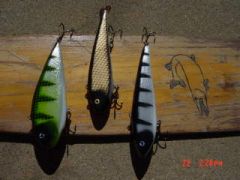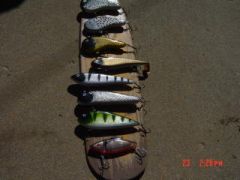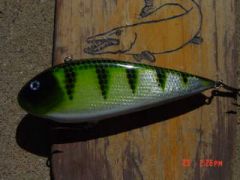
tinman
TU Member-
Posts
50 -
Joined
-
Last visited
Content Type
Profiles
Articles
TU Classifieds
Glossary
Website Links
Forums
Gallery
Store
Everything posted by tinman
-
While traveling down life's proverbial highway, who are you going to help? The guy on his way to work with his hood up & steam coming out his radiator, or the guy standing along side of the road with a nap sack & his thumb out. They're both trying to get somewhere! I know Loco, you weren't looking for a free ride. You're obviously a good contributor to this site. But on the cyber hi-way you see all types. It's kind of hard to tell the difference, sometimes. In the information age we're in you can pretty much hit the key board & find out anything you want. Maybe it's a generational thing, but some of us old guys look at things a little differently. JMHO and sorry to get off subject. Good luck on your project.
-
Here's another good read. It actually shows how different color water filters color and affects it's visibility. http://www.mepps.com/fishing_articles/article.php?id=77
-
Exactly, it's kind of hard to exactly categorize a lure. But maybe more by action & how it's worked. For example: It gets kind of fuzzy when somebody says jerk bait. To a Musky guy it might be a Suick or a Burt. But to a bass or walleye guy it's a Husky Jerk. Which might also be categorized as a crank bait or a twitch bait. Same with a TripleD. They're kind of the crescent wrenches of lures I guess. There's so many variables & subtleties I almost hate to get started. But to me a hybrid has qualities of different types of lures. I've got some lures (old Cobbs) that float, with the eyelet on top of the head making it dive when pulled. It's tail weighted like a glider so I can hold the rod tip up & work it slow on the surface with a WTD action. Or hold the tip low & work it fast & get a WTD action underwater. Or just fish it in long pulls like a Suick. And a lot of lures use these differences in weighting, shape etc.. in design. Another example is cranks. Some are center weighted, like a Super Shad Rap. Some are weighted both just ahead & just behind center. Some are tail weighted. Mostly to make them better for a certain way of using them. Twitching, cranking, jerking, trolling, casting..... whatever.
-
There's kind of the sticker there. To a Musky guy, a glider doesn't float. A WTD (walk the dog) surface lure does, but maybe to bass guys thats a glider. Or maybe it's just me, dunno. :)I've made some that are kind of hybrids that float but dive under when pulled & have a walk the dog action when worked rapidly. But to some that's technically a jerk bait (like a burt). But also it's an example of the little differences in baits & weighting & what you can do to make them work the way you want. The sinkers can have a walk the dog action underwater, too. And some great hang time, too depending on weight. And some are erratic & glide up & down & left & right. Recently I made 6 gliders (& jerks?)with exactly the same body shape. 2 floaters, 2 neutrals & 2 slow sinkers. Different weighting, different eye location gives each a different action & application. Now if I can just catch a fish on one!?
-
The lure building index (Dirks) has some great stuff. But there are many, many ways to weight-a-bait. What I like to do is build & seal a prototype or two with out any intention of finishing it. Drill extra holes in it or get some adjustable weight system going and have fun. To me it's time better spent, rather than ending up with a finished lure that looks great, but doesn't have the action you wanted. Doesn't take long to see why certain lures are weighted the way they are and what to do to make a lure do what you want it to do. After all, everybody knows it's the action of a lure that's most important (right?).
-
I've got a combination disc/belt sander. I set my disc table at 45 deg. & knock off the edges equally, then round off with a dremel or rasp. Really saves alot of time.
-
Personally, I just hold an appropriate sized piece of stainless steel wire in my vice grips & heat it up with a lighter. Rotate it a little & push it carefully through.
-
Great repaint. The old wooden ones were the best. I've still got one I retired many years ago that had most of the paint ripped off by pike. Forgot about it. Thanks for the reminder & link, too.
-
-
I just posted some pics of some lipless cranks I've been working on this summer in the Hardbait gallery if you're interested. They're not exactly Traps, but same principal. They're larger Pike & Musky size, 4 - 8 inches approx. Lipless cranks are one of my favorites (obviously) because they're so versatile. Can crank, twitch, rip, troll & jig them. I kinda tried to design each one a little different for different applications. Some are floaters for shallow presentations, some sinkers for deep fishing & jigging. A couple have the eyelets near the nose like a Musky jerk bait. Some about 1/3 of the way back like a traditional trap. Some with more than one eyelet at different locations for different depth, actions etc... Maybe it'll give you some ideas to try. I'm still learning myself, but I can tell you what little I know. The first ones I made I got the pattern from: http://www.lurebuilding.nl/indexeng.html
-
-
-
-
http://www.mcmaster.com/
-
I had some of the old Reef Runners with the outbarbs. They were OK for walleye & smaller fish, but just didn't hold up to salmon, so I changed them all out. Didn't really see any advantage to the design change anyway.
-
Yes sir, get a standardized design & do multiples really speeds things up. I can't even imagine how much time some of the guys on here have into some of the swim baits posted. Unbelievable. Alot of the details take extra time, of course. Jointed lures like I mentioned already. Foiling & scaling, prism tape etc., adds another dimension & a few more steps. Weighting time can vary, too. If you're shooting for a neutral, slow riser or sinker, gotta tank test those (or lake if ones nearby). Thru-wire if you're into that. And some of the deep diver lips with wire line ties are tricky. Hand carves, ad infinitun..... Then throw in the proto-type work........ Fun, fun, fun!
-
No, because 50 degree water is denser than 70 degree water.
-
I've had good luck with them. It's a small Ma & Pa business so if you give them a call chances are you'll be able to talk to the owner Dick himself & not some keyboard operator like some of the bigger companies. They go to Arizona in the winter so don't order then, found that out the hard way, oh well.
-
Moores has lots of Musky components. http://www.mooreslures.com/ Rollie & Helens, look in blades, also components. http://www.muskyshop.com/modules/web/index.php/id/1
-
Same here. If you get abit of a flaw, don't worry about it. The second coat of 2T will go on easier & take care of it. Sometimes a little light sanding the spot will benefit it. On smaller lures, with a little practice, you can get most with one coat. On big Musky lures I almost always put on 2 coats & sometime 3 before I'm satisfied. More suface area is just harder to put on perfect.
-
Used to get my rattle beads from Northland Tackle, but for some reason they're unable to get them (last I knew) any more. Might try Xtreme Tackle, they used to sell them & fluoro., too. "Rattle bead" search maybe? Good luck.
-
Very nice design. Don't know where you're located, looks like salt water, though. I know those would be a hit on the Great Lakes, too. Troll alot of squids & trolling flies with flasher/dodgers for salmon here. The colors & eyes are great.
-
It's tough starting out. A beginner doesn't really want/need a full course in hydrodynamics. But yes a tutorial on basic design would be helpful I'm sure. I always say, study the classics & go from there. And like BobP suggested, master the basic mechanics & you're on the right path. Not to get off subject, but my tip/advice is build some prototypes just for the sake of experimentation after you decide which style you'd like to try. If you butcher up some wood playing around, who cares? Build some with metal lips so you can bend the lips/angles or drill out eye holes. Move 'em around. Some of my protos have 3-4 eyelets on them just to see what happens. If you want to experiment with weighting, drill some holes from the nose to the tail and slip some shot in and move it around just to see. Lauri didn't get it right the first time I'm sure!
-
Great looking lures & pic's. The area up there around the Soo are a little slice of fishing heaven, aren't they?
-
This one maybe? http://www.tackleunderground.com/forum/showthread.php?t=9119&page=2&highlight=lexan




